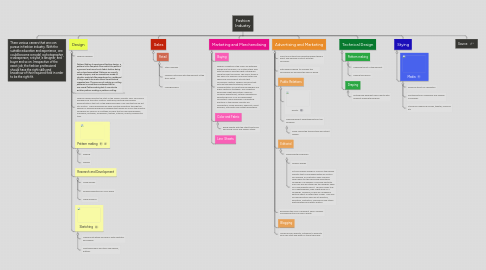
1. There various careers that one can pursue in fashion industry. With the suitable education and experience, one could become a model, a photographer, a salesperson, a stylist, a designer, and buyer and so on. Irrespective of the exact job, the fashion professional should have the right skills and knowhow of their required field in order to be the right fit.
2. Design
2.1. Fashion Designer
2.2. Pattern Making In sewing and fashion design, a pattern is the template from which the parts of a garment are traced onto fabric before being cut out and assembled. Patterns are usually made of paper, and are sometimes made of sturdier materials like paperboard or cardboard if they need to be more robust to withstand repeated use. The process of making or cutting patterns is sometimes condensed to the one-word Patternmaking but it can also be written pattern making or pattern cutting.
2.3. Fashion Design denotes the start of the fashion industry flow. Successful designers are the initial creators sketching, painting and building demonstrations that act as the beginning signs of an idea that will be put into motion. These professionals build creative inspiration through the upkeep of absorbing fashion knowledge that ranges all across the industry. Designers are found in a multitude of areas that include womenswear, menswear, footwear, accessories, textiles, interiors, events, packing and toys.
2.4. Pattern making
2.4.1. Draping
2.4.2. Sewing
2.5. Research and Development
2.5.1. Mood boards
2.5.2. Finding inspiration for color board
2.5.3. Trend research
2.6. Sketching
2.6.1. Making Flats either by hand or with illustrator and Figures
2.6.2. Swatching fabric and trims like zippers, buttons
3. Sales
3.1. Retail
3.1.1. Store manager
3.1.2. Helping customers with the garment at the store outlet
3.1.3. Managing sales
4. Marketing and Merchendising
4.1. Buying
4.2. Fashion Marketing is the major link between design and the public. For instance they deal with the idea of how the right clothing will reach the right consumer. The job of those in this field is to examine consumer tastes and show how a brand best fits into that consumer’s lifestyle. Fashion lines must get noticed through storytelling, and the implementation of advertising campaigns and public relations strategies. The marketing employed might work within a specific company department, outside marketing or advertising firms or as an independent consultant. Some examples of marketing positions in the fashion industry are copywriters, media planners, publicists, event planners, journalists and market researchers.
4.3. Color and Fabric
4.3.1. Being update with the latest trents and upcoming colors and fashion styles.
4.4. Line Sheets
5. Advertising and Marketing
5.1. Direct and Interactive Marketing where there is direct and personal contact with the consumer.
5.2. Data base browsing to see who the consumers are and how the sales is going.
5.3. Public Relations
5.3.1. Events
5.3.2. Making different advertisements for the company.
5.3.2.1. Show casing the trendy styles and street fashion.
5.4. Editorial
5.4.1. Working with Magazines
5.4.1.1. Graphic Design
5.4.1.2. Art and Graphic Design is a field in the fashion industry that is overlapped within all sectors. For example, an illustrators skills could be called upon for the upcoming advertising campaign of a designer. The same illustrator may very well be utilized by the designer again for a new website layout. This also holds true for a photographer, who might work on a campaign, lookbook, as well as a magazine editorial shoot all within their career. This area includes positions such as art directors, animators, illustrators, commercial and studio photographers and photo editors.
5.5. Examining the color of different fabric samples. And keeping track of fabric quality.
5.6. Blogging
5.7. Having a blog, website, Instagram to promote your own style and whats in trend these day.
6. Technical Design
6.1. Pattern making
6.1.1. Checking the fit of the garment
6.1.2. Making tech packs
6.2. Draping
6.2.1. Testing how different fabric reacts with different draping techniques.
7. Stying
7.1. Media
7.1.1. Personal stylist for Celebrities
7.1.2. Photoshoots for magazines and Fashion companies
7.1.3. Styling for media e.g movies, theater, musicals etc

